Honeywell HPA300 Review
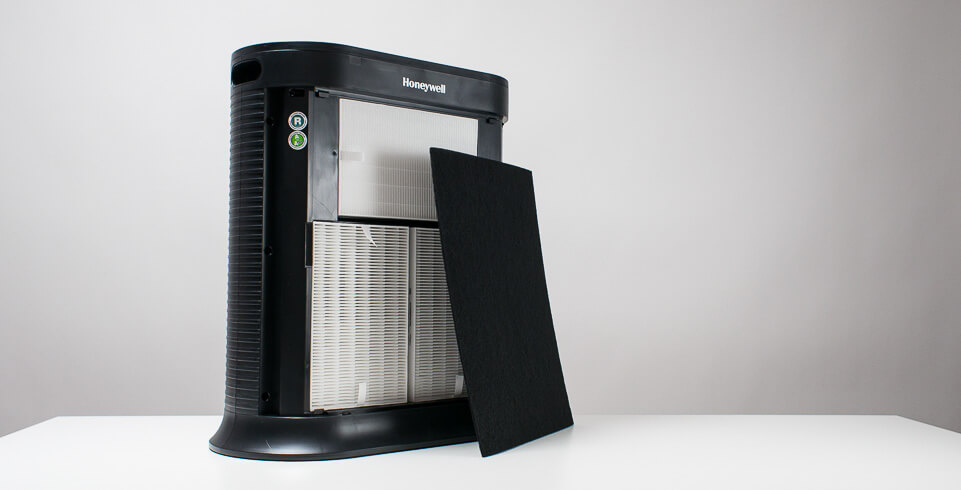
Feature Scores
Pros
- High CFM – processes more air more quickly than most other air purifiers on the market
- True HEPA filter – industry standard particle filtration quality
- Good CFM/dB ratios – low noise output considering its high CFM
- Control panel lights can be completely turned off
- Heavy but handles on each side make it fairly portable considering its greater weight
Cons
- Poor energy efficiency - well below average CFM/watt ratio on all speeds especially the lowest fan speed
- No dedicated pre-filter – carbon filter doubles as pre-filter
Editor's Score
Quick Facts
| Particle filter type | HEPA |
|---|---|
| Gas filter type | Carbon |
| Pre-Filter | No dedicated filter - carbon filter doubles as pre-filter |
| Output | Approx. 320 CFM |
| Air Movement | Front grille > carbon filter > HEPA filter > up and out of top of unit |
| Number of fan speeds | 4 – low, medium, high, and turbo |
| Size | 22.5 in. tall x 19 in. wide x 11 in. deep |
| Weight | 16.5 lb. |
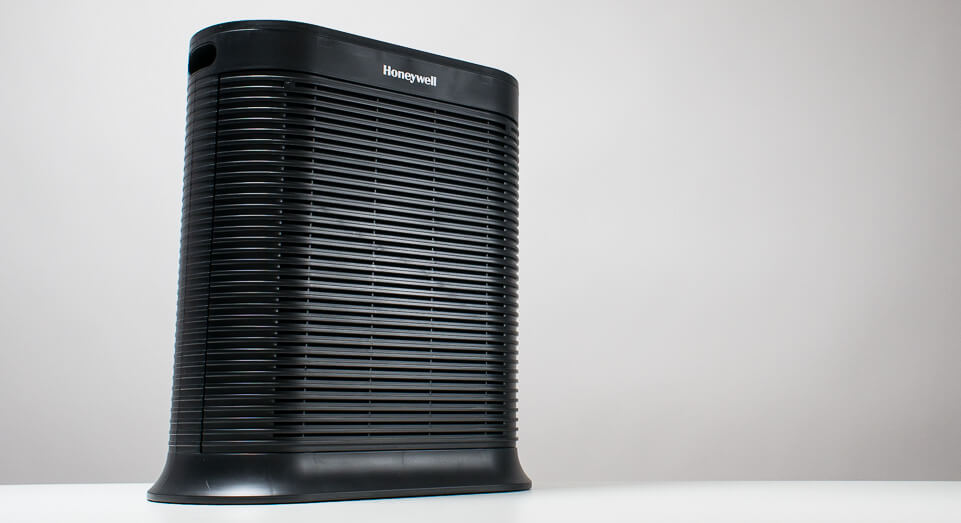



Analysis
A step by step breakdown of the HPA300's performance.
Air Processing Performance
Test Results
In an approx. 150 sq. ft. test environment, the Honeywell HPA300 lowered room particle concentration from 10,000 particles per cubic ft. down to 1,000 particles per cubic foot in 9 minutes. The latter concentration – 1,000 particles per cubic ft – is what we consider to be the maximum concentration for “clean” air in a residential environment. Thus, the HPA300 was able to lower room particle concentration to clean levels in a 150 sq. ft. room in 9 minutes.
The HPA300’s time of 9 minutes is a little slower than what we expected. Units in the 200 to 250 CFM range – a considerably lower output than the approx. 320 CFM (cubic ft. per minute) of the HPA300 - accomplished the same feat in approx. the same time. For example, the Winix 5500-2 and Coway Mighty air purifiers lowered room concentration from 10,000 down to 1,000 particles per cubic ft. in 9 and 10 minutes, respectively. These units output at 250 CFM. We would have expected the HPA300 with its greater output and similar filtration quality (all of these units have HEPA particle filters) to lower room concentration a little faster.
For example, the approx. 430 CFM Coway Airmega 400 lowered room concentration by this same amount in only 4 minutes. With an output in-between 430 and 250 CFM we would have expected the HPA300 to lower room particle concentration in a time in-between that of the AirMega and Winix – around 6 minutes.
After 16 additional minutes the HPA300 was able to lower room particle concentration down to the lowest level it was able to achieve - 100 particles per cubic ft. The aforementioned Winix 5500-2 and Coway Mighty took an additional 6 minutes and 13 minutes, respectively, to accomplish the same feat. Thus, both the Winix and the Coway were able to lower room particle concentration to this very lower level slightly faster than the Honeywell. This was a surprising result considering the greater output of the Honeywell.
With an extra 70 or so CFM the Honeywell is able to process 70 additional cubic feet of air every minute compared to the approx. 250 CFM Winix and Coway. Despite this advantage it took approx. the same amount of time to lower room particle concentration from 10,000 down to 1,000 particles per cubic ft. and more time to lower it even further down to 100 particles per cubic ft. Why? We don’t really know.
As we’ll show in the next section, the HPA300 has the exact same particle filter type as the Winix and Coway – HEPA. With greater output it should be able to push more particles through its filters faster and lower particle room concentration faster. But it didn’t, and we simply don’t know why.
Filter Analysis
Particle Filter
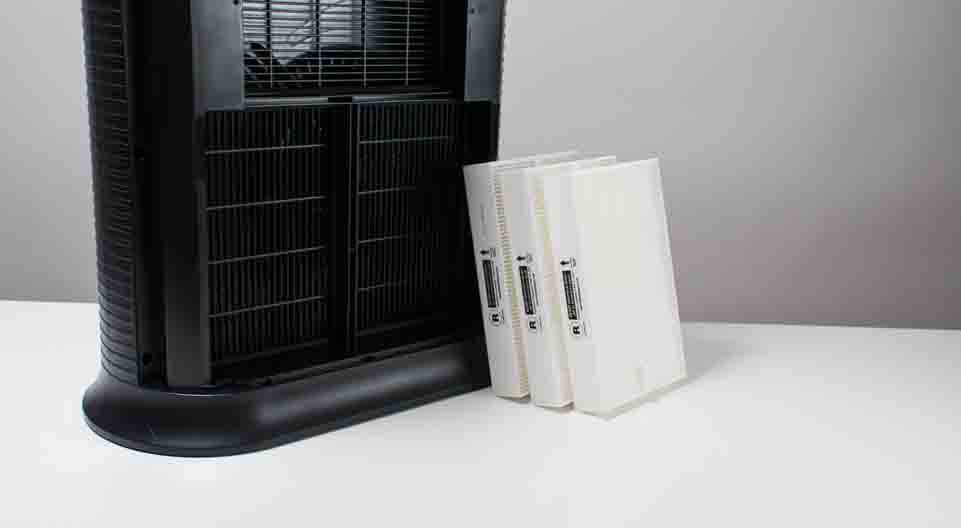
The HPA300 is equipped with three HEPA filters. The filters are stacked next to each other in a compartment inside the air purifier.
Note that the filters are stacked next to each other, and not behind each other. If they were stacked behind each other filtration quality would increase exponentially as the few particles that would make it through the first HEPA filter on the first pass would almost certainly get captured by the second or third filters in the stack.
But this is not the way the HPA300 is set up. It only uses 3 different filters because it uses the same smaller filters as the HPA200 and HPA100. Honeywell has decided to use the same filters for each air purifier in the HPA line (likely because it lowers manufacturing costs as only one type of filter has to be manufactured for three different air purifiers). The number of filters is simply increased as the output is increased.
The HPA100 has only one filter with approx. 110 CFM of output. The HPA200 has two filters with approx. 200 CFM of output. And the HPA300 has three filters with approx. 320 CFM of output.
HEPA is the industry standard for particle filtration. A HEPA filter removes 99.97% of particles 0.3 microns and larger that travel through it.
The HPA300 has three of them, but again, they’re stacked next to each other, not behind each other. And so filtration quality should be just as good with the HPA300 – with three filters - as it is with all other air purifiers on the market that have only one HEPA filter, at least theoretically. In practice, we saw units with similar filters (also HEPA) and less output outperform it in our testing.
Gas Filter
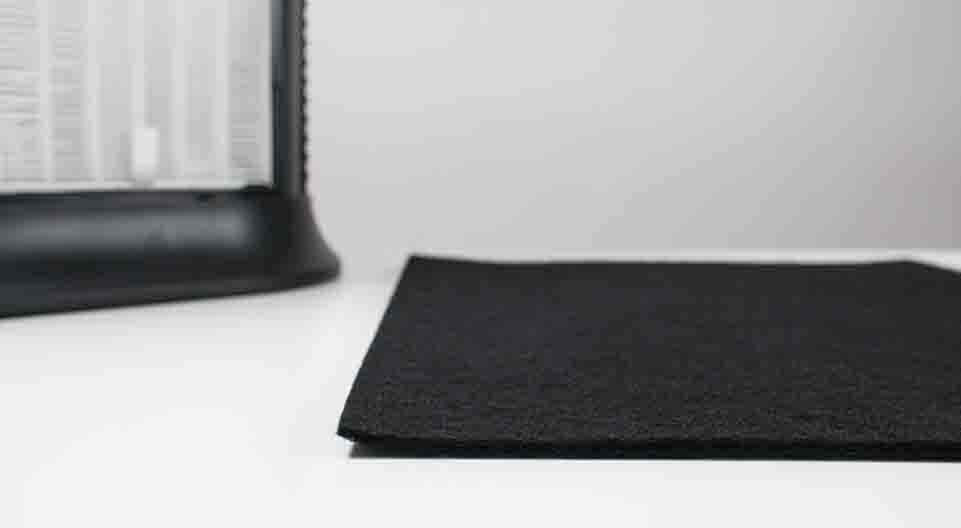
The HPA300 is equipped with a single carbon filter to filter out unwanted gases like odors and VOCs. The carbon filter is made of a fibrous material that is simply coated with carbon.
If gas filtration is a priority for you, we would recommend going with a unit that has a different type of carbon filter. For example, the Winix 5500-2 is equipped with a carbon filter that contains actual carbon pellets. This type of carbon filter is more effective in filtering unwanted gases than the fibrous carbon coated type installed on the HPA300.
Pre-filter
The HPA300’s carbon filter also doubles as a pre-filter to capture larger particles. Compare this set up to the Winix 5500-2 and the Coway Mighty which both have a separate dedicated washable mesh pre-filter.
When the HPA300’s carbon filter saturates with large particles it has to be replaced at cost. When the Winix or Coway’s pre-filter saturates with large particles it can easily be vacuumed or rinsed clean for free.
Clearly, the latter option (washable pre-filter) is the better way to go as it reduces long term cost of ownership. The fact that the HPA300 doesn’t have a separate washable pre-filter is a strong negative for it in the category, especially considering its high price. Usually, this combining of the carbon and pre-filter is a cost cutting measure we see implemented on budget air purifiers. It should not be the solution for a higher priced air purifier like the HPA300.
Air Movement
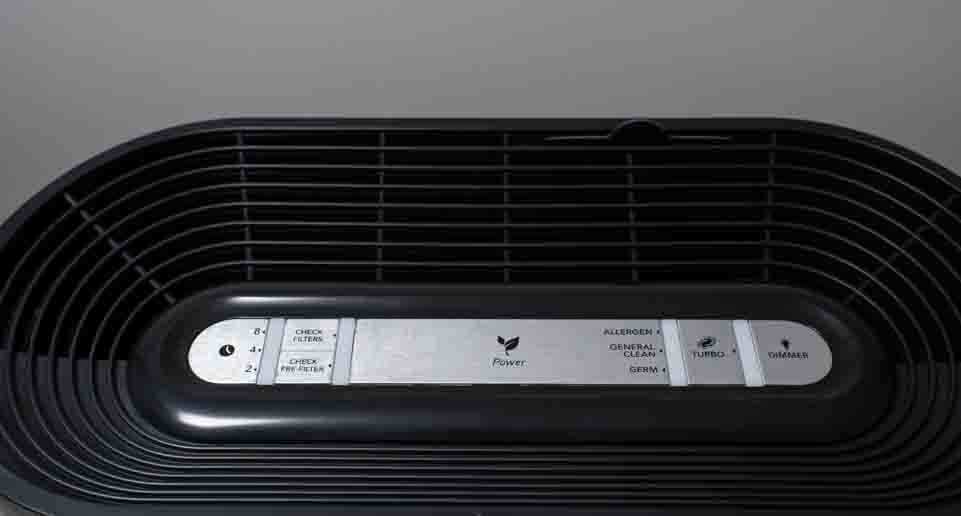
The HPA300 has very high output – approx. 320 CFM. This means it can process 320 cubic ft. of air every minute.
Budget air purifiers in the sub $100 range usually output at approx. 100 CFM. Top rated units like the Winix 5500-2 and Coway Mighty output at approx. 250 CFM.
Usually, greater output translates into two things
- faster air cleaning in smaller rooms
- sufficient air cleaning in larger rooms – and usually the greater the output the greater area of coverage.
Let’s talk about faster air cleaning in smaller rooms first. The HPA300 certainly cleans air very fast in smaller rooms (around 150 sq. ft.) but, as our testing has shown, it will not necessarily clean air any faster than similarly equipped 250 CFM units like the Winix 5500-2 and Coway Mighty. So if you’re buying any of these units to clean air faster in smaller rooms, there’s really no reason to pay more for the greater output of the HPA300.
For cleaning the air in larger rooms things get quite a bit more complicated. Our testing has shown that a 250 CFM unit like the Winix 5500-2 and a 430 CFM unit like the Coway AirMega clean the air in an oversized room (300+ sq. ft.) just as fast and to the same level of clean (approx. the same low particle concentration).
The bottom line is that anything more than 250 CFM in a single air purifier in an oversized room really makes very little difference in terms of overall air cleaning performance in such a room.
And so, because 250 CFM units are much cheaper than higher CFM units like this HPA300 or the Coway AirMega, we always recommend a 250 CFM unit over a higher CFM unit for oversized rooms. If you need an air purifier for a large oversized room we would recommend a single 250 CFM unit like the Winix 5500-2 or Coway Mighty to start, and additional 250 CFM units as required. For example, if you find running a single 250 CFM unit doesn’t lower room particle concentration sufficiently, we would recommend trying to run two 250 CFM units next.
Even at 320 CFM, we would not recommend the HPA300 for any room larger than about 300 sq. ft.
Energy Efficiency
The HPA300 exhibits extremely poor energy efficiency.
On max. fan speed at approx. 320 CFM of output it draws 131 watts of power. On its lowest fan speed at approx. 80 CFM it draws 42 watts of power. This gives it a CFM/watt ratio of 2.4 on its highest fan speed and 2 on its lowest fan speed.
For comparison, the top rated Winix 5500-2 has a CFM/watt ratio of 4.6 on its highest fan speed and 11.9 on its lowest fan speed. This means that the Winix is almost twice as energy efficient on its highest fan speed and close to 6 times as efficient on its lowest fan speed compared to the HPA300.
Now, it is important to note that the HPA300 does not draw a lot of power relative to other popular appliances. For example, a clothes dryer usually draws between 1000 and 4000 watts of power. A coffee maker can draw as much as 1400 watts of power. The HPA300 only draws about 130 watts on maximum settings.
However, first of all, the HPA300 is usually run for several hours at a time – maybe even 24/7. These other high power draw appliances are only run for a few minutes or a few hours.
Second, the HPA300 is still much less energy efficient than most other air purifiers on the market. If you’re comparing the energy costs of running the HPA300 compared to a top rated unit like the Winix 5500-2, the Winix is simply the much better bang for your buck over time. It’s going to give you more CFM for less $$ (less watts) because of its much better CFM/watt ratios.
Noise Output
The HPA300 did reasonably well in our noise output testing.
On max. fan speed it did have a very high noise output of 71.2 dB but it was also outputting at 320 CFM. For comparison, the HPA200 was measured at 69.6 dB on the same setting but at an output of only about 200 CFM. The Winix 5500-2 was measured at 67.5 dB but at only 250 CFM of ouput.
On its lowest fan speed the HPA300 had a decent CFM/dB ratio at 1.73 but its overall noise output was still quite high at 48.3 dB. For comparison, the Winix 5500-2 was measured at approx. 40 dB on its lowest fan speed albeit at a lower CFM/dB ratio of 1.64.
In other words, the HPA300 gives you good CFM considering its dB on its lowest fan speed but the dB is still quite a bit higher than it is for comparable units. There is no “whisper quiet” setting for the HPA300.
Other units give you less CFM on their lowest settings but are able to output more quietly on these settings.
Durability
The HPA300 is made of the exact same materials with the exact same build quality as the HPA100 and HPA200. It is simply physically larger and heavier.
The problem here is that the HPA300 retails for approx. $225. Other units in this price range are better built with higher quality parts. The HPA300 is built with the same level of workmanship and using the same materials as an approx. $100 air purifier in the HPA100.
Like the HPA100 and HPA200, the HPA300 also comes with a 5 year warranty. This is just about as long of a warranty as you’ll find on the market. IQAir air purifiers come with a 10 year warranty (if they’re registered with the manufacturer) but they retail for $800+. The aforementioned Winix 5500-2 comes with only a 1 year warranty and the Coway Mighty comes with a 3 year warranty although both units are better built with higher quality parts than this Honeywell.
Ease of Use
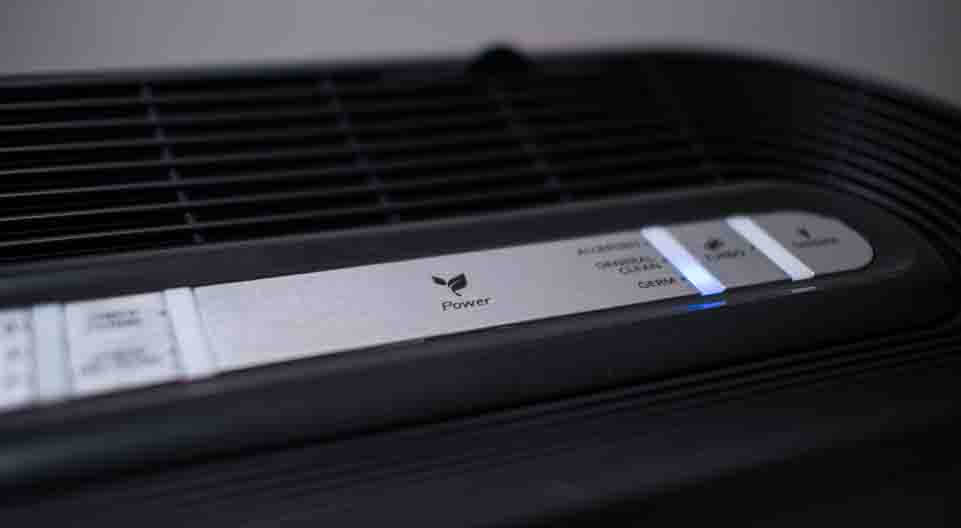
All three HPA series Honeywell air purifiers have essentially the same control panel. All three units have a control panel with LEDs that can be turned off. There’s an actual dimmer switch that allows you to set the LEDs to high power, low power, or turn them off.
This is a rather unique feature. Many air purifiers have control panel LEDs that cannot be turned off. For example, the top rated Winix 5500-2 and Coway Mighty both have control panel LEDs that cannot be turned off.
The HPA300 weighs approx. 16.5 lb. making it one of the heavier air purifiers we tested. It is also one of the largest air purifiers we tested. This is unsurprising as it was also one of the higher output air purifiers we tested. The fan size and fan motor size/weight dictate how large the air purifier chassis needs to be and so, with approx. 320 CFM of output, it’s absolutely necessary that this unit is as large and heavy as it is.
That being said, it’s still highly portable. 16.5 lb. is substantial but it’s quite light compared to any compressor based appliance like a portable AC unit or a dehumidifier. The unit also has two side pocket handles which makes it quite easy to pick it up and move it around.
Top rated 250 CFM units like the Winix 5500-2 and Coway Mighty weigh slightly less (in the 12 to 15 lb. range) and are slightly smaller – the Coway, especially is much smaller than the HPA300.
The HPA300 does come with a timer that will turn it off on a delay. It does not come with a remote or any Smart functionality (in other words, it cannot be controlled via an app on a phone). Both the Winix and Coway also come with a timer. The Winix also comes with a remote while the Coway does not. Neither unit can be controlled with an app.
Value
The HPA300 is a rather low value air purifier. First of all, it comes with a high initial price tag. It usually retails for approx. $225 but it will often sell for upwards of $300 in big box stores. Even considering its above average output (320 CFM), this still a higher price than it should be. This unit has a lower CFM/$ ratio than many other air purifiers on the market.
The second concern here is energy efficiency. Earlier we talked about this unit’s poor energy efficiency. And this results in greater energy costs for what you get compared to most other air purifiers on the market.
Finally, it would be remiss of us not to mention this unit’s high filter replacement costs. Remember, this unit takes three HEPA filters. The problem is that these HEPA filters are priced for the HPA100. If you’re an HPA100 owner and you’re buying a single replacement filter, the cost of that single filter is very reasonably.
However, when that cost is multiplied by three times it becomes excessive. Expect to pay upwards of (approx.) $80 for a full replacement of all three of the HPA300’s HEPA filters. Filter replacement for comparable units like the Winix 5500-2 and Coway Mighty runs somewhere in the $40 to $60 range. Of course, both the Winix and the Coway have slightly less output than the HPA300 but the filter replacement cost to CFM ratio for those units is still much better than it is for the HPA300.
Add a Comment
Have a question or comment? Let us know below.

Comments (4)
What is the CFM for each power setting of the HPA300? I can see Turbo is 320 and lowest is 80CFM. Just calculating full # of air exchange s per hour based on a couple of different room sizes.
Great site and amazing YouTube video reviews. Thanks.
The HPA300's output was measured at approx. 170 CFM and 250 CFM for those two fan speeds in between low and turbo.
Gret review! The winix 5500-2 looks like a solid choice. But I chose the HPA300 due to availability and lower price. The winix 5500-2 usually lists in Canada around $400-600. I can get an HPA300 for $220-300.
The HPA300 does 250cfm on the 3rd speed and does so fairly quietly - I’m sure the winix 5500-2 only does 250cfm at its highest setting which is going to be louder.
The winix 5500-2 is rated at 70watts at 250cfm according to the label on the back of the unit. The HPA300 draws 75watts at 250cfm. So much for the efficiency advantage. Plus you can blast the HPA300 on turbo to really clean the air faster at 320cfm.
Filters: I buy cheap knock offs for the HPA300 for $8-10 each x 3 = $24-30 total (not including prefilters). The cheapest I could find for the 5500-2 was $50 (with prefilter). HPA300 wins again.
Last but not least you can make your own filters for the Honeywell’s using inexpensive “hammock filter” furnace filters from your hardware store. If you are resourceful you can order the carbon media online as well (it’s aquarium filter carbon). The hammock filters are usually rated between MERV 3 - 8 = they make great prefilters and are dirt cheap. MERV 10 hammock filters do exist and are almost as good as the MERV 13 both units run. My only complaint is since the Honeywell filters are smaller you have to make more of them - but it’s easy and they are washable / reusable making them dirt cheap.
Winix 5500-2 specs look great - but the HPA300 and 200 are my hands down favorite. They are virtually silent at the lower speed settings and make a soothing white noise for sleeping on the higher settings.
Again great review. It’s hard making a purchase decision based on all the variables. The cheap filters and high performance / efficiency of the HPA300 are what did it for me.
Even if the 5500-2 can do 250cfm at 54watts the HPA300 only uses 75watts. Plus it’s cheaper, widely available and it’s replacement filters are cheaper / you can make your own that are close to HEPA ratings.
Have a great day!
I bought the HPA300 and it worked very well for almost one month. Then it stopped working and generated a burning electrical smell. I unplugged the unit and shipped it back to amazon.
Hello,
Question on the HPA300 ce per mode:
You’ve mentioned in this article that max. fan speed is approx. 320 CFM and lowest fan speed is approx. 80 CFM.
Does this means that for Allergen it is 80cfm and in Turbo mode it is 320cfm?
Would you know how much cfm is General mode and Germ mode?
Thanks,
Remi
Yes, the output was measured at approx. 80 CFM on the lowest fan speed and it was measured at approx. 320 CFM on the highest fan speed (turbo). The output was measured at approx. 170 and 250 CFM, respectively, on the other two fan speeds you mentioned.